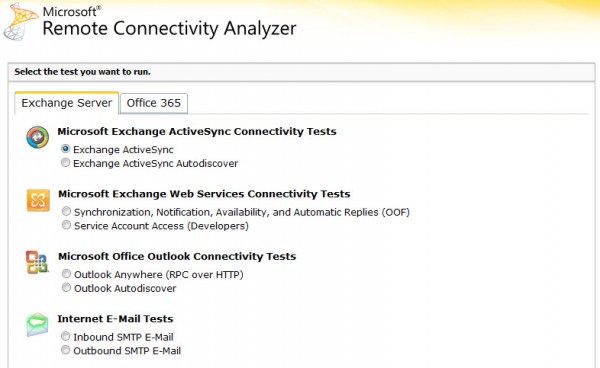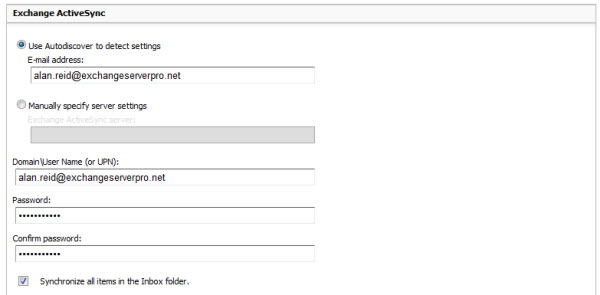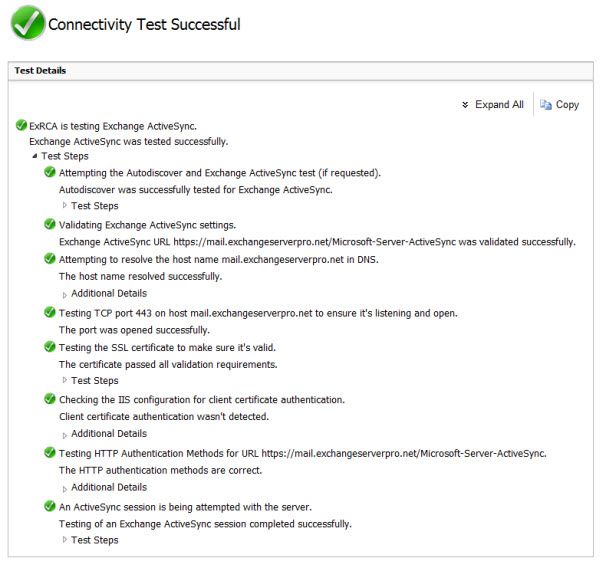Here is a quick tip for one of the most under-utilized testing tools for Exchange Server 2010. If you ever find yourself needing to test ActiveSync for an Exchange 2010 environment, and you either don’t have an ActiveSync-capable smart phone handy or you’re trying to determine whether the phone you do have might be the problem, you can use the Microsoft Remote Connectivity Analyzer instead.
The Remove Connectivity Analyzer is a web page that lets you test multiple different connectivity types as though you were sitting outside of the network.

There are two tests you can perform:
- Exchange ActiveSync – simulates all of the steps that a mobile device would use to connect to Exchange and sync mailbox items. You can perform this test using both Autodiscover and using manually configured server settings.
- Exchange ActiveSync Autodiscover – tests just the Autodiscover process for automatically determining the server configuration settings.
Performing each test is as simple as filling out a web form.

The real value in this tool is how it reports on the results of the test. There is a lot that can go wrong with an ActiveSync deployment, such as DNS problems, incorrect firewall rules, misconfigured Exchange 2010 SSL certificates, and more. The Remote Connectivity Analyzer outputs a test report that breaks down each of the steps that it performed and gives you success/error details for each one, letting you know where you need to start any troubleshooting.
 This tool has definitely saved me a lot of time and headaches in the past. So next time you’re troubleshooting an ActiveSync problem give the Remote Connectivity Analyzer a go.
This tool has definitely saved me a lot of time and headaches in the past. So next time you’re troubleshooting an ActiveSync problem give the Remote Connectivity Analyzer a go.



Hi Paul,
I am Coexisting 2010 to 2013, ExRAC all test case is green, but external Activesync still cannot connect and outlook anywhere still try to connect. Just only OWA is fine on external network. I dont how to do for trouble shoot first……….
Thanks for support.
Gary
We have 2 DC, 2 DNS & 2 Exchange Server.
1 server has Windows Server 2008 R2 Ent. Installed. It has DC, DNS & Exchange Server 2010 SP3.
Now we bought a new server. Installed Windows Server 2012 R2 Std.. I installed DC, DNS & Exchange Server 2010 SP3 on this server. Both the servers are doing replication. Both servers are Global Catalog. Both are in in same site & same domain.
MAPI & OWA is working for new server but ActiveSync is not working.
The Real Person!
Author Paul Cunningham acts as a real person and passed all tests against spambots. Anti-Spam by CleanTalk.
Exchange 2010 is not supported to run on Windows Server 2012 R2. That probably isn’t the cause of your problem, but you definitely need to fix that.
Exchange was installed successfully on Windows Server 2012 R2. It passed all the prerequisites checks. Also it shows me mailbox databases for both Exchange Servers (new & old). I also created some test mailboxes on new exchange and configured outlook on client computers. It is working fine(MAPI). OWA is also working but only problem is mobiles are not able to connect with the new server. But when i gave old server address for new exchange mailboxes in mobiles it connects with old server.
The Real Person!
Author Paul Cunningham acts as a real person and passed all tests against spambots. Anti-Spam by CleanTalk.
Even if you managed to get it to work, it’s not supported. There’s no point trying to fix the other problems until you’ve redeployed the server on a supported OS.
How do I test Active Sync Internally in my network?
Where are the connection logs stored for ActiveSync?
The Real Person!
Author Paul Cunningham acts as a real person and passed all tests against spambots. Anti-Spam by CleanTalk.
You can test with a device or with a device emulator, as long as the ActiveSync URL resolves in DNS and is accessible internally.
ActiveSync connections are logged in the IIS logs on the server.
Hi ,
what can be the issue ?
If an iphone download emails until a specific time and date and wont download more email.
Even the sync limit is select to No Limit.
An IISreset took care of this. The integrated windows authentication was turned on in EMS not on IIS, but still it appears an IISreset was needed to enable the feature after it was selected. Thanks for your time
Hi Sir Paul,
Can you please check the result of Microsoft Connectivity Analyzer.
The Microsoft Connectivity Analyzer is testing Exchange ActiveSync.
Exchange ActiveSync was tested successfully.
(Edit: Looks like it was successful? I’ve removed the rest of the results. Please don’t copy/paste hundreds of lines of logs into comments here)
Hi Sir Paul,
Can you please check the result.
Attempting to test potential Autodiscover URL https://ictsi.com:443/Autodiscover/Autodiscover.xml
Testing of this potential Autodiscover URL failed.
The issue is we can’t sync email to the Phone.
All of your posts are very specific and clear, so thank you in advance.
I have an issue where I am not able to successfully connect via ActiveSync to a 2010 CAS/HUB with mailboxes on Exchange 2003. The process works perfectly fine for mailboxes on Exchange 2010, but when using the Microsoft remote connectivity analyzer it fails at “Options” It is worth noting that locally ActiveSync to this same 2003 server fails as well. The only time that it works is when ActiveSync is directly accessed via the public FQDN that is then directed to the Exchange 2003 server. Both the Exchange 2003 and 2010 servers are in the same AD forest/domain, so the process should just be a simple proxy from the 2010 CAS/HUB. Also, when looking at the event log on the CAS/HUB there is an event ID showing that the ActiveSync connection is just taking too long. Any ideas on what to look at at, I am beside myself on this one as normally ActiveSync proxying just works. I’ve also added the necessary hotfix on Exchange 2003 to be able to set integrated windows authentication on the activesync virtual directory in EMS.
The Real Person!
Author Paul Cunningham acts as a real person and passed all tests against spambots. Anti-Spam by CleanTalk.
If you’re 100% sure the necessary hotfix and co-existence config is in place then the next place to look is the IIS logs on the 2003 server to see whether the proxied traffic is reaching the 2003 server or not, and what response is being logged (eg HTTP 404 errors).
Also worth double-checking that inherited permissions is enabled for the AD user objects.
I am 100% sure on the hotfix, as this was put into place today and it allowed me to then select integrated windows authentication, prior to the hotfix this option was greyed out. What co-existence file are you referring to? I thought that ActiveSync just simply proxied once it found in AD that the mailbox was on the exchange 2003 server.
The Real Person!
Author Paul Cunningham acts as a real person and passed all tests against spambots. Anti-Spam by CleanTalk.
If you enabled integrated auth using the IIS management console that is contrary to the advice Microsoft gives in this blog post.
http://blogs.technet.com/b/exchange/archive/2009/12/08/3408985.aspx
Hi Paul,
Did you encounter the error below when trying to test the Active-Sync:
…….. Completed !
Testing HTTP Authentication Methods for URL https://mail.domain.com/Microsoft-Server-ActiveSync/.
The HTTP authentication test failed.
Tell me more about this issue and how to resolve it
Additional Details
The Initial Anonymous HTTPS request didn’t fail, but Anonymous isn’t a supported authentication method for this scenario.
HTTP Response Headers:
Content-Length: 147
Cache-Control: private
Content-Type: text/html; charset=UTF-8
Date: Tue, 10 Mar 2015 10:54:43 GMT
…….
The Authentication Setting of Exchange-Active-Sync Virtual Directory in IIS Setting is only Basic Authentication. I tried enabling the Anynomous Authentication Mode for Exchange-Active-Sync Virtual Directory but the error above still occur.
But afterall, my Sony Xperia Z Utra is still able to connect to Mailbox using Exchange Active Sync Protocol. So is there any misunderstanding here ?
Do you mind to explain What does this sentence refer:
“The Initial Anonymous HTTPS request didn’t fail, but Anonymous isn’t a supported”
Thank you Paul
I’m looking foward your reponse !
Sincerely !
Hi Paul,
Picking up victors question Re scheduling a test, I am wondering if you have any insight/knowledge of SCOM (system centre operations manger) and the synthetic transaction provided with the Exchange Management Pack for scom. The documentation is a bit light of detail but this is what it is supposed to run:
ActiveSyncConnectivity Internal Test-ActiveSyncConnectivity -MonitoringInstance:$ScriptContext.ManagementGroupName -TrustAnySSLCertificate:$true -LightMode:$true
I am guessing the fact it states it is an ‘Internal’ test it might only be testing connectivity withing AD/trust boundary wereas this remote tool will test coming in externally through DMZ?
Reason for question is our activeSync server sits in DMZ- at least thats my understanding, I’m not the involve in our Exchange/mobile solution design and I’ve just recently been asked to monitor it. So was just wondering since we DO use SCOM if we could get away with the built in Synthetic Trans in the Exchange MP or do we still need to have this external type test and if so can we automate it from Microsoft tools like SCOm or Orchestrator.
Thanks
The Real Person!
Author Paul Cunningham acts as a real person and passed all tests against spambots. Anti-Spam by CleanTalk.
The ExRCA tool is a manual tool. I’m not deeply familiar with SCOM so I can’t really comment on that.
However, if your CAS are in a DMZ you’re running an unsupported topology there.
http://blogs.technet.com/b/exchange/archive/2013/02/18/exchange-firewalls-and-support-oh-my.aspx
Pingback: Fix Test_service_sync_checkservererror.js Errors - Windows XP, Vista, 7 & 8
Pingback: mastercard not working online
This tool doesnt accept an IP address for the ‘Exchange ActiveSync server:’ field (?!) – as thats all we use is there another way to test? It gives ‘this field entry is an invalid format..’ – is it really this limited?
The Real Person!
Author Paul Cunningham acts as a real person and passed all tests against spambots. Anti-Spam by CleanTalk.
Correct. Why not just create a DNS record?
Paul,
This may be a little off-topic, but is there a way to send an sms message to a user’s phone to automatically configure the mail/server activesync settings?
Maybe this is a silly question, but phone carriers can do it, so I thought why not ask.
That would be sweet.
Hi,
we are implementing activesync to show the inbox from our exchange server. it`s working as we expect.
we have the small problem in some special character like [€,†,‡] in this character not showing correctly instead it show some junk characters [â¬,â,Æ]. please help me to solve this problem.
thanks,
Suresh
This is great for hands-on “manual mode” testing, but what about an automated and scheduled test that can send alerts when an ActiveSync client cannot connect?
I use a service called Mailive that performs this kind of test for general mail service. It sends an email into a mail system to an autoresponder address which sends it back. Each email is tagged with a serial number and round-trip times are reported via a web page. If the round-trip time exceeds a configurable timeout an alert is sent to an admin’s email.
If such a service or PC-based application exists for ActiveSync I would be interested in it. Any thoughts?
hi.
I would like test my exchange active sync but i use public ip and nat ports to exchange server private ip adress.
This tool not let use numeric public ip, on alfanumeric domain.
Could you help me for test my activesync since outnet?
The Real Person!
Author Paul Cunningham acts as a real person and passed all tests against spambots. Anti-Spam by CleanTalk.
The ExRCA only works with domain names, not IP addresses. If you want to test with an IP address I would really suggest you set up a DNS record for it and do it the right way.
Otherwise you’ll need to use a mobile device for your testing. If you don’t have any available you can try setting up virtual Android devices for it instead:
https://www.practical365.com/exchange-activesync-virtual-android-device
I just thought of something, would it be possible that this test fails because our ActiveSync police does not allow non-complaint devices?
The Real Person!
Author Paul Cunningham acts as a real person and passed all tests against spambots. Anti-Spam by CleanTalk.
Possibly. Try adding your test mailbox to a separate ActiveSync policy that doesn’t have that restriction.
My ExRCA tests have never failed with the default ActiveSync policy though.
Looks like my assumptions were spot on, changed the policy so it allowed for non-compliant devices and I was able to run the tests from both, ESM and Remote Connectivity Analyzer
Here are the results
CasServer LocalSite Scenario Result Latency(MS) Error
——— ——— ——– —— ———– —–
server01… SITE Options Success 109.20
server01… SITE FolderSync Success 280.80
server01… SITE First Sync Success 140.40
server01… SITE GetItemEstimate Success 187.20
server01… SITE Sync Data Success 390.00
server01… SITE Ping Success 2023.23
server01… SITE Sync Test Item Success 78.00
Thanks!!!
Hey Paul, do you happen to know why the FolderSync Test fails, I have tried this with Remote Connectivity Analyzer and with Test-ActiveSyncConnectivity
Sample
Scenario : FolderSync
ScenarioDescription : Issue a FolderSync command to retrieve the folder hierarchy.
PerformanceCounterName : DirectPush Latency
Result : Failure
Error : [System.Net.WebException]: The remote server returned an error: (403) Forbidden.
HTTP response headers:
MS-Server-ActiveSync: 14.1
Content-Length: 1233
Cache-Control: private
Content-Type: text/html
Date: Mon, 13 Aug 2012 02:40:02 GMT
Server: Microsoft-IIS/7.5
X-AspNet-Version: 2.0.50727
X-Powered-By: ASP.NET
Pingback: Very useful tool for testing Activesync | Foremist Computing